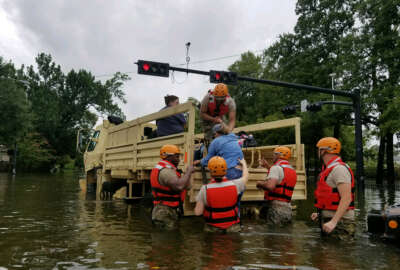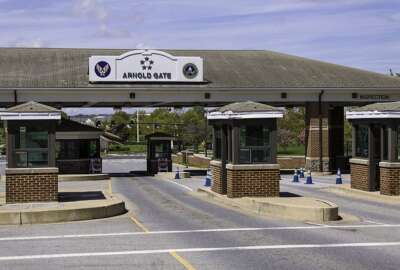
Marines stay put while thousands of other military members evacuate from Florence’s path
Military installations in the path of Hurricane Florence are preparing to protect families and equipment.
As Hurricane Florence makes its way to the eastern shore of the U.S., military bases in the storm’s path are making preparations to keep their employees safe and to provide aid to civilians bracing for the potentially catastrophic storm.
Multiple military bases directly in the storm’s path already sent out evacuation orders to active duty, reserve and civilian personnel.
However, one base is standing its ground, despite being directly in the storm’s projected track. Marine Corps Base Camp Lejeune in North Carolina is not issuing a mandatory evacuation order.
“Many evacuation routes are vulnerable to flooding, and hotels and fuel supplies are likely already overwhelmed making it very dangerous to travel from and then back to Camp Lejeune when the storm is over,” Brig. Gen. Julian Alford, the base’s commander said in a Tuesday statement.
Alford contended the base — the Marines’ largest on the East Coast — has a hardened infrastructure and support system to deal with the hurricane. That includes security, emergency response and the ability to produce and distribute its own water and power.
“The majority of Camp Lejeune is NOT in a flood prone area. We have very reliable historical data on what areas would be affected by storm surges and flooding and have already directed the relocation of those personnel and residents away from those vulnerable locations,” Alford wrote.
The base will use a fitness center, elementary and middle school for shelters during the storm. Alford asked those using the shelters to bring a three-day supply of water and food.
Alford later addressed some criticism on his decision in a separate Facebook post.
“There have reportedly been multiple comments that the decision to remain in place at Camp Lejeune is ‘all about the money,” Alford wrote. “The commands and personnel who remain are well-postured to react to situations and will be working together, like Marines always do in battle, to get through Hurricane Florence. Those personnel who determined they would rather depart were and are allowed to do so with enough warning to find shelter where they deem most suitable.”
Meanwhile, bases that were under mandatory orders to evacuate included seven installations in the Hampton Roads region of Virginia. Those bases alone employ 83,000 active-duty military members, plus thousands more civilians and reservists.
“The safety of our personnel and their families is my top priority right now,” said Rear Adm. Charles Rock, the Navy Region Mid-Atlantic commander. “Our mission is to support the fleet, fighter and family and the team at Navy Region Mid-Atlantic has been working around the clock to provide support and information during this very stressful time.
The evacuation will remain in effect until Sept. 16 and individuals will be reimbursed for lodging and given per diem.
Sens. Tim Kaine (D-Va.) and Mark Warner (D-Va.) wrote to DoD on Tuesday to offer assistance in protecting military facilities and personnel ahead of the hurricane.
“As sea levels rise, these installations in particular have faced increased frequency and severity of flooding in recent years. Given the critical role that Hampton Roads military installations play in supporting our nation’s security, we ask that you keep us apprised of any assistance you may need to ensure the safety of service members and their families, installations, and infrastructure, and to swiftly address any potential damage resulting from the storm. We look forward to working with you to ensure that the military is able to quickly recover following Hurricane Florence,” the senators wrote to Defense Secretary Jim Mattis.
Other areas in Virginia, North Carolina and South Carolina are following suit. All of those states, plus the District of Columbia and Maryland are currently under a state of emergency.
Marine Corps Air Station Cherry Point in North Carolina released all nonessential personnel at noon Tuesday. The base opened up two shelters, one of which is pet friendly.
Joint Base Charleston in South Carolina is under Hurricane Condition III alert status starting Tuesday. Personnel and their families were ordered to evacuate on Monday.
“Due to potential complications associated with high tides, flooding, and tropical storms, the limited evacuation order is in effect and Joint Base Charleston members are in the process of evacuating. We want to remind everyone to ensure you are in contact with your chain of command for questions concerning your evacuation plan,” Col. Terrence Adams, 628th Air Base Wing and Joint Base Charleston commander said in a Sept. 11 release.
As of Tuesday, the South Carolina National Guard mobilized about 2,000 soldiers and airmen.
“We have guard members preparing throughout the state, ready to meet the requests from our partnered agencies and emergency managers,” said Army Maj. Gen. Robert E. Livingston Jr., the state’s adjutant general. “We are well-positioned with people, and as needs increase, we will activate additional soldiers and airmen.”
Latest Defense News
North Carolina placed 320 guardsmen on active duty to integrate into North Carolina’s emergency management disaster response plan. There are an additional 7,000 North Carolina guardsmen ready to mobilize if needed.
Virginia will bring up 1,500 guardsmen and members of the Virginia Defense Force on active duty. Another 6,000 are on standby.
Potential missions for the Virginia National Guard include high-water transportation, debris reduction, commodity distribution, shelter management assistance and rotary-wing aviation search and rescue, a DoD release stated.
As for the equipment on the bases, U.S. Fleet Forces Command ordered all Navy ships in the Hampton Roads area to sortie. Nearly 30 ships will be directed to areas of the Atlantic Ocean to avoid the storm.
Some units will not get underway due to maintenance status but will be taking extra precautions to avoid potential damage. Commanding officers have a number of options when staying in port, depending on the severity of the weather. Some of these options include adding additional mooring and storm lines, dropping the anchor, and disconnecting shore power cables, a Monday release stated.
“Our ships can better weather storms of this magnitude when they are underway,” said U.S. Fleet Forces Commander Adm. Christopher Grady.
Langley Air Force base ordered all of its F-22 Raptor and T-38 Talon aircraft to the Rickenbacker Air National Guard Base in Ohio to wait out the storm.
Copyright © 2025 Federal News Network. All rights reserved. This website is not intended for users located within the European Economic Area.
Scott Maucione is a defense reporter for Federal News Network and reports on human capital, workforce and the Defense Department at-large.
Follow @smaucioneWFED






